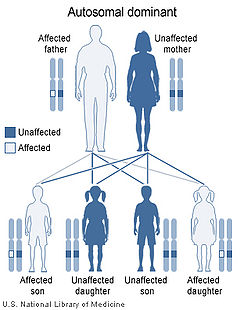Medicine:Craniosynostosis, Philadelphia type
| Craniosynostosis, Philadelphia type | |
|---|---|
 | |
| Autosomal dominant inheritance |
Craniosynostosis, Philadelphia type is a rare autosomal dominant syndrome characterized by sagittal craniosynostosis (scaphocephaly) and soft tissue syndactyly of the hands and feet. This condition is considered a form of acrocephalosyndactyly.[1][2][3]
Signs and symptoms
Features of this condition include:[1][3]
- Sagittal craniosynostosis (dolichocephaly/scaphocephaly)
- Mitten-like syndactyly
Facial features in this condition are usually normal.
History
In 1996, a distinct form of acrocephalosyndactyly was reported in five generations of a single family. Over these five generations, an autosomal dominant pattern of sagittal craniosynostosis and soft tissue syndactyly was noted. The syndactyly was mitten-like and resembled Apert syndrome but was excluded as being caused by Apert syndrome due to the lack of bony involvement.[2]
Causes
This condition is caused by duplications in chromosome 2 near-identical to those responsible for syndactyly type 1 (Chromosome 2q35 Duplication Syndrome).[2]
References
- ↑ 1.0 1.1 "Craniosynostosis, Philadelphia type (Concept Id: C1832590)" (in en). https://www.ncbi.nlm.nih.gov/medgen/321988.
- ↑ 2.0 2.1 2.2 "#185900 - CHROMOSOME 2q35 DUPLICATION SYNDROME" (in en-us). https://omim.org/entry/185900?search=Craniosynostosis,%20Philadelphia%20type&highlight=craniosynostosi%20philadelphia%20type.
- ↑ 3.0 3.1 "Craniosynostosis, Philadelphia type - About the Disease - Genetic and Rare Diseases Information Center" (in en). https://rarediseases.info.nih.gov/diseases/1601/craniosynostosis-philadelphia-type.
 |

